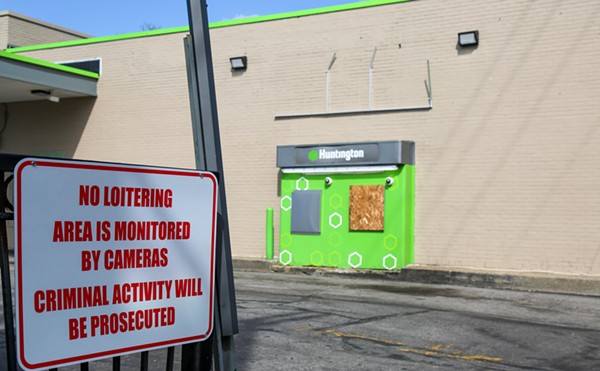THE AFFAIR
Like a lot of young women with impeccable penmanship and a compulsion to anthologize, Christina Gaston had a handwritten list of her favorite things in the world: Love for my family. Going to the movies. First snowfall. Driving to music lessons and performances. Christmas. Libraries. Museums.
Gaston worked at the Cleveland Museum of Art in the development office from September 2009 to November 2012. She then took a job as the managing director of ChamberFest, a summer concert series.
She was a woman of disarming beauty, charisma and compassion; a woman who relished the smell of dusty bookstores, collected antiques before it was trendy, a woman who made Audrey Hepburn look frankly plain. She was a woman who was not above walking a mile through snow in heels to volunteer; a woman who loved, above all, music. She cultivated that love in the Dominican Republic when she lived there with her family, playing the violin at a very young age, back when the instrument's body was roughly the size of her torso. She'd practice for hours a day, a testament to her passion.
Only when a serious injury short-circuited what might have been a promising music career – she'd obtained academic degrees in music and played in ensembles from Battle Creek to Poland – did she find solace in her love of museums and a job at CMA.
It was there she met Franklin; they started a romantic relationship sometime in early 2012. It would continue, with one reported interruption, during and after Gaston's departure from the museum. Franklin was and is still married with two children.
They were in love, though, and had designs on marriage. Franklin claimed he was in the middle of divorce proceedings with his wife; he had in fact moved out of his Shaker Heights home, which the museum helped pay for, and into an apartment in Uptown on Euclid Avenue in September, 2012. They would be together once his divorce was final, free to move away and look for other jobs, he told her. (Franklin has since moved back into his Shaker Heights home.)
They'd traveled together to Spain, where Franklin was giving a speech, and had an overseas trip to Italy booked and planned for the first week of May – a week after her death.
Sources described the relationship as an "open secret," even though Gaston herself was a very private person. Franklin was acutely concerned about his reputation and appearances – when Gaston and he attended the same event, they would act like nothing was going on – and worried about people discussing the affair. He'd still appear socially with his wife.
After her death on April 29, news of Gaston's suicide spread quickly, if unofficially, through the museum's various departments. Many of the higher-ups knew immediately – one high-ranking museum official was disseminating the news to those tied into the Cleveland arts scene the next day, for example. And Laura Bidwell -- wife of trustee and current interim director Fred Bidwell -- was very close with Christina Gaston and knew about the suicide soon enough to send flowers to the Gaston family for Christina's funeral in Georgia on May 5.
Some employees emailed about the news; others subsisted on rumors for weeks. One former employee says he'd always thought that it was Gaston's sister who had found her. Though Gaston was no longer employed at the museum at the time, colleagues were "surprised" and "appalled" that no official word was given to the staff.
For the most part, however, Gaston's passing was so private and well concealed that many of her close friends were unaware of the news. Her birthday was in early May, less than two weeks later, and one CMA coworker described the horror of watching Christina's Facebook page erupt with predictably jolly wishes.
There was no obituary in local papers, though. Christina's older sister, Cassandra, said it wasn't necessarily surprising. "We're very private people," she told Scene.
A memorial service was held for coworkers and friends at the Cleveland Institute of Art Cinematheque, where Christina had volunteered every other Saturday taking tickets, but that wasn't until July 22, nearly three months later.
Whether or not the death of a young woman on the rise in Cleveland's cultural community was newsworthy remains a question of taste. But David Franklin's presence and the couple's relationship, which the museum was at least aware of, should have instantly been subject to scrutiny. Instead, the museum sat in silence and Franklin continued operating as its director.
THE NIGHT CHRISTINA DIED
Christina Gaston's bedroom in the old brick apartment building on Euclid Heights was cluttered with the accessories of a stylish, artsy 34-year-old woman -- books, high heels, shopping bags, a rolling black suitcase with clothes piled on top. On one side of her bed is a lint roller resting on the ledge of the music stand that must have held hundreds of pages of Christina's sheet music as she played her violin. On the other side is a white nightstand on which sits an old paperback copy of Larry Niven's science fiction book, The Ringworld Engineers, next to her Hello Kitty alarm clock and a copy of Italo Calvino's The Baron in the Trees.
She died there on April 29.
According to Cleveland Heights police officer Andrew Trhlin's official report that night, he and officer Douglas Olp got a call at 12:13 a.m. -- Sunday night into Monday morning -- to respond to a report of an unconscious woman at the apartment. David Franklin had just dialed 911 to report finding his friend hanging. They arrived and were flagged down by Franklin waiting for them outside and led to the apartment's back door and then the bedroom, where they found "an unresponsive white female in the rear bedroom leaning over the bed." Her face and hands were purple, and there was a white rope hanging from the ceiling fan, "the other end of the rope was near Gaston's head, however, we could not confirm it was around her neck due to her positioning on the bed, her hair, and the heavy green coat she was wearing." At 12:20 a.m., Cleveland Heights fire showed up -- police and fire respond to calls like this in tandem -- and she was officially pronounced dead six minutes later. Trhlin called the county coroner's office at 12:51 and an investigator showed up a half hour later.
When police (and then the county medical examiner's office) arrived, her 5'2", 116-pound lifeless body was no longer hanging, but leaning over the side of the bed next to her nightstand. Her legs were underneath her on the hardwood floor (as if she were kneeling), torso leaning up against the side of her bed with her face down and arms stretched out in front on top of it. She wore a green herringbone coat over a long sleeve white shirt, long black skirt and shin-high black socks.
The rope -- perhaps as thick as a dime -- was wrapped once to make a simple overhand knot around a single metal stem that connects a wooden blade to the base of the ceiling fan. Sitting on the other side of the bed was a pair of scissors and an unused pile of the same rope material with a perfectly and cleanly tied noose with a hangman's knot on one end. Elsewhere in the apartment police found some of Gaston's prescriptions: tizanidine (a muscle relaxant), trazodone (an antidepressant) and Cymbalta (for depression and anxiety). In the kitchen was an opened bottle of red wine, a used wine glass, and four bowls on the ground -- two filled with dry cat food and two filled with water -- for her two cats. Not found anywhere that night, in either her apartment or car, was her iPhone. No suicide note, either.
David Franklin was described as "extremely emotionally distraught" by Trhlin. In his report, he wrote:
"While waiting for coroner to respond, I spoke further to Franklin. Franklin stated at 2000 hours the previous night [8 p.m. Saturday], he received a text message from his friend Christina Melinda Gaston stating that she was "depressed from work." Franklin stated after he did not hear back from Gaston, he responded to her apartment to check on her. Once at her apartment, Franklin stated he went to her front door and rang her apartment door bell. Franklin stated Gaston did not respond, however, he noticed her apartment lights were on and her interior patio door was open. Franklin stated he then went to the back door and again was unsuccessful making contact. Franklin stated he found that the back door was unlocked and he entered the apartment. Once inside, Franklin stated he located Gaston unconscious in the bedroom (north side of the apartment). Franklin stated he immediately contacted emergency services and stood by until police arrived. Franklin, who was visually upset, completed a brief written statement."
That's it for David Franklin on the scene. Police didn't ask to see the "depressed from work" text message he said Christina sent him. Nor did they ask him about Christina's missing phone. Later records show police dismissed him before the medical examiner showed up.
HOLES IN THE INVESTIGATION AND QUESTIONS FROM THE FAMILY
Christina Gaston's family down in Georgia might have been far removed from the scene in sheer mileage but they were more involved in the case than any local institution or agency. For months after her death, unsatisfied with the investigation and official story, they had pieced together their own investigation. And they prodded Cleveland Heights police incessantly for answers to lingering questions.
For instance, where was her phone?
It was never recovered, but the family did have partial phone records from Christina's account, and that information showed definitively that she never sent a text to David Franklin that Saturday night, the one he claimed said she was "depressed from work." In fact, only one text was sent that day, to a graphic designer who did work for ChamberFest. The phone was still active, though, the night Franklin found her body: a data transfer from the phone was sent at 12:22 a.m., minutes after Franklin's 911 call, and another at 2:34 a.m., explained to the Gaston family by an AT&T technician as an establishment to a local cell tower. The Gaston family had plenty of questions and, in September, the Cleveland Heights police assigned the case to a detective. (City Law Director Gibbon downplayed the action in a conversation with Scene as a "courtesy to a distraught stepfather" and not an official investigation.)
By Oct. 23, however, two days after Franklin "resigned" from the museum, police still had not bothered to ask David Franklin about Christina's cell phone. According to the case report, on that day, Franklin's attorney, Virginia Davidson, called the detective to ask if her client was under investigation for Christina's death. The detective said, "We received a call from Ms. Gaston's stepfather and that we were trying to resolve some 'questions' the family had," but any formal investigation would have to be conducted by the coroner. But, "I told Davidson that we still did not know the location of Gaston's phone and whether her client knew of its whereabouts and whether he could address any other 'questions' the family had."











